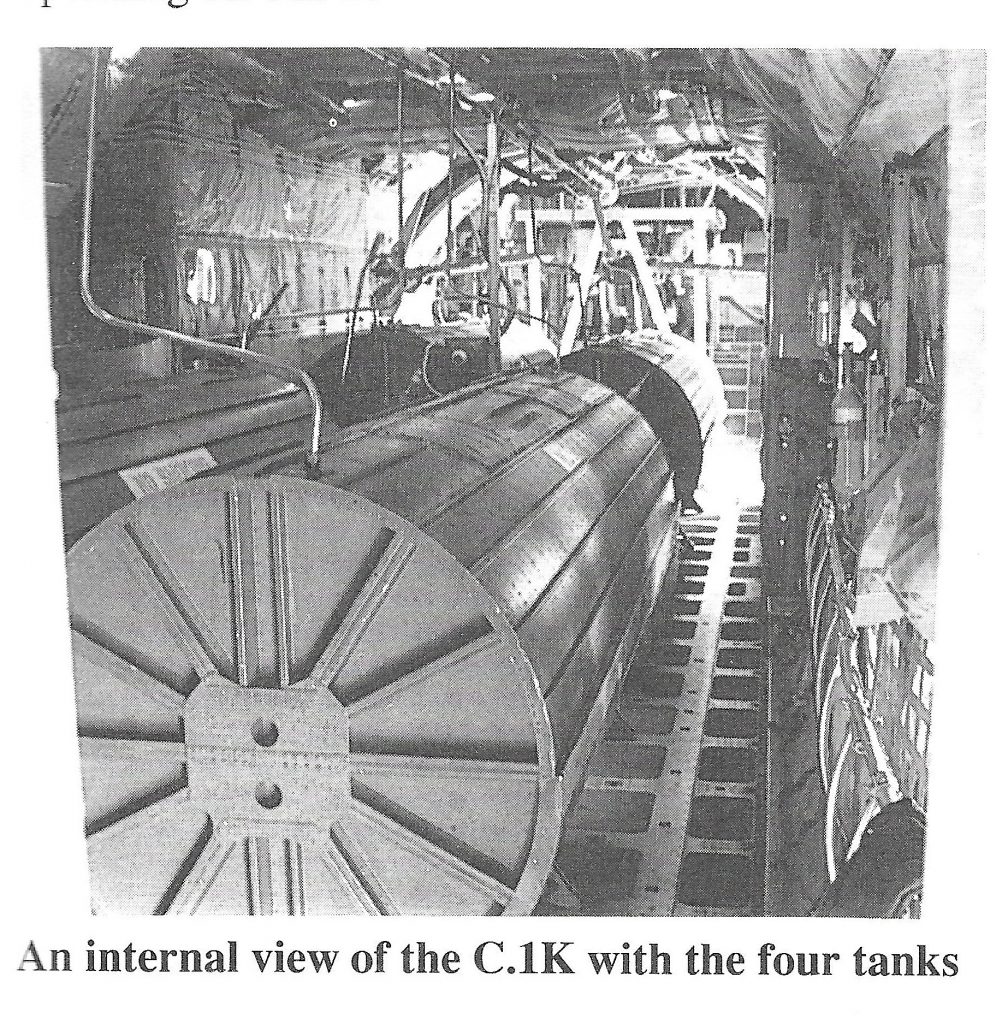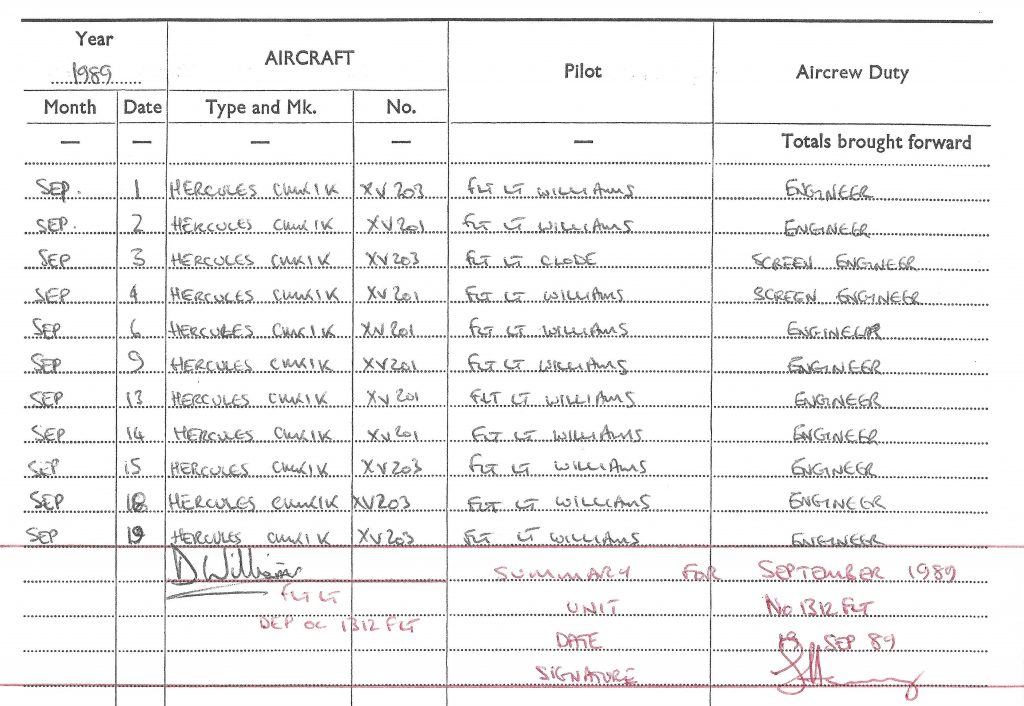Thanks to MEng Ian Harvey for this submission.

Whilst in RAF Mount Pleasant for our 4 month detachment we did once a month patrols of South Georgia and the South Sandwich islands. Two reasons
1. To re-supply, by airdrop, the Marines detachment in Grytviken Bay, S Georgia,
2. To patrol the whole coastline where req’d looking for Argentinean infiltration (as happened pre Falklands war.)

This was a considerable trip, not many en route diversion airfields (!), the main diversion if MPA out for any reason was Montevideo Uruguay, min fuel required from overhead MPA 30k!! This, at the time, could only be done in the C130 tanker, needing all of the wing fuel and the fuselage tanks.
You could only use the fuselage tanks after there was enough room for the fuel in the wing tanks, we normally emptied the external tanks (18000lbs/2300gallons) flew it on the inboard wing tanks (aux tanks) then refilled the ext’s from the fuselage tanks it being impossible to burn the fuselage tank fuel directly. The fuselage tanks (there were 4of them) held 28000lbs between them (3500galls) so one fill for the ext’s would use 18000 lbs of this, this fuel we could burn whilst transferring which took some time leaving us with a more or less full wing (63000lbs, 8000galls) after about 6 hrs of flight. The max AUW for the tanker was 175000lbs.
The fuselage tanks were range extender tanks taken from Andovers, they would have had one, perhaps two, we had 4. The output of all 4 (they were on the CofG, was taken to an electric pump, the pump, and there was only one, was taken from a Lynx helicopter and it was the only way to either move or burn the fuselage fuel. It was therefore imperative it was working, and well, before PNR!! The hose drum unit was fed from the a/c jettison gallery (Dump mast valves closed, and checked closed!)

This pump was mounted above the height of the fuselage tanks and was not self priming. It may have worked from previous or on ground use, but may not. To prime it (remember we NEED this fuel) a small can of fuel was carried, in the freight bay. A cap on the pump body was removed and filled with this fuel to prime the pump! After that, hopefully it pumped as planned. Being fairly new to the tanker I’d never had to do this, now here we were heading 180 Degs away from our diversion, external tanks now near empty. All went well and we arrived at South Georgia with empty fuselage tanks and more or less full wing tanks!
On our first trip to S Georgia, the island was out in low cloud, we certainly weren’t going to descend anywhere near that. As Grytviken is on the north of the island, we overflew the island then went some considerable distance North more than 50 miles from memory, then turned through 180 and located the island on radar from low-ish level, in VMC conditions. As we approached the island, like magic, the cloud got less and less, it was just like layers of silk curtains being pulled open one at a time, a magical experience. Once closer it was safe to continue as planned.
Once at Grytviken we had to drop mail and medical supplies etc, in “harness packs” the same harness a paratroop would use, each holding about 120 lbs of weight. Normal drops would be 12 of these, and only one could be dropped at a time as the Marines had to recover them one at a time too. They were dropped by the Loadmaster through the stbd para door. The Marines were not allowed more than 2 boats in the water, one acting as a lifeboat, so it couldn’t be used for picking up the packs. Also they had to be at their dock before the next drop. The drop involved flying into the bay, large mountain at end of bay(!),do the drop then turn as fast as poss to get back out of the bay again for obvious reasons! Each drop would take at least 8 mins so more than 1 ½hrs was used just for this.

After that the patrol round the remainder of S Georgia was completed, all at low level, before climbing to max altitude for the transit to S Sandwich. Same again there, but all visual from low level, on one of our trips the islands were completely ice bound, huge tabular icebergs, all merged together, we seriously looked closely at them as possible emergency landing areas, no kidding!
After that, back to highest poss altitude for the transit back to MPA, arriving overhead with more than the 30000lbs minimum diversion fuel to Montevideo!
So, the fuel burn, assuming landing with 30000 was 58000lbs, about 11 hrs allowing for the excess burns at low level.
On one trip we had with us as a passenger (loose term) the new Commander British Forces Falkland Islands (CBFFI) then Gp Capt latterly Air Marshal Cliff Spink. He was my divisional officer on my first posting after my Halton apprenticeship, then a Flt Lt on 111Sqn Lightnings at RAF Wattisham. Next time we met was when he came to visit 1312Flt as the new CBFFI, recognised each other instantly! Part of his “patch” was S Georgia and the S Sandwich Islands so it was our pleasure to take him to see them. On the way back we were called by MPA and told that due to snow on the runway we were to divert to Montevideo!!! Sir got on radio, said something like CBFFI here, this aircraft will be landing at MPA, make it so! We did!
Just another day in the office!! Got some awesome photos as you’d imagine, not many people alive on this planet have been to most of that trip!
Ian Harvey

